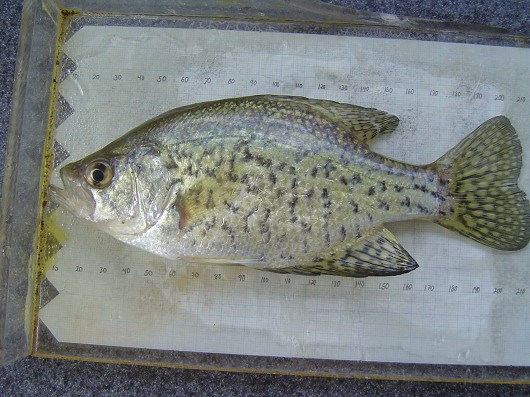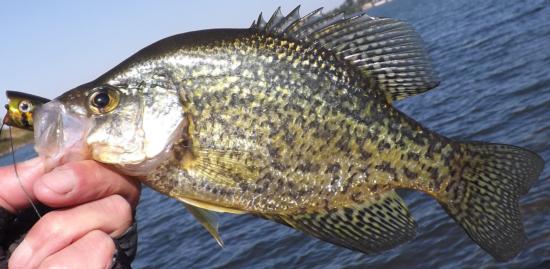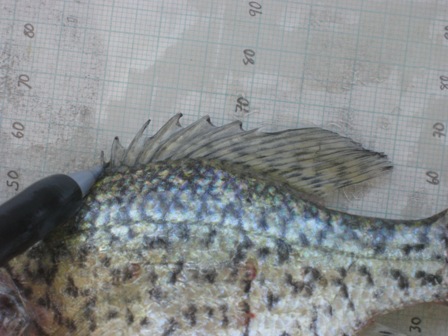Black Crappie
-
Scientific NamePomoxis nigromaculatus
-
NativeNon-Native
-
Identification
 Black crappie, captured in rotary screw trap on the Sacramento River at Knight's Landing on 2/26/2009. Photo by Dan Worth, California Department of Fish and Game.
Black crappie, captured in rotary screw trap on the Sacramento River at Knight's Landing on 2/26/2009. Photo by Dan Worth, California Department of Fish and Game. Black crappie. Captured and released in the Delta Cross Channel, near Walnut Grove, CA, 5 June 2013. Photo by Gary Riddle.
Black crappie. Captured and released in the Delta Cross Channel, near Walnut Grove, CA, 5 June 2013. Photo by Gary Riddle. Black crappie, showing dorsal fin with 7 spines, captured in rotary screw trap on the Sacramento River at Knight's Landing on 3/7/2009. Photo by Nicholas Miguel, California Department of Fish and Game.
Black crappie, showing dorsal fin with 7 spines, captured in rotary screw trap on the Sacramento River at Knight's Landing on 3/7/2009. Photo by Nicholas Miguel, California Department of Fish and Game.- Deep, laterally compressed bodies and small sloping heads depressed above the eyes
- Whitish-silvery side coloration with heavy black spotting of indistinct pattern, a dark back, and a white belly
- Anterior will turn nearly solid black when breeding
- Dorsal fin is placed at back of body with rounded end symmetrical to the anal fin
- Dorsal fin has 7-9 spines and 15-16 fin rays, anal fin has 6 spines and 17-19 rays, pectoral fins have 14-15 rays and pelvic fins have 1 spine and 5-6 rays
- 38-44 scales on the lateral line
-
Life History
Black crappies (pronounced "croppie") are most commonly found in large, warm water lakes and reservoirs. Optimally, this water is between 27°C and 29°C but black crappies have been seen hunting at 6-7°C and are not under lethal conditions until 37-38°C. Black crappies can also be found in salinities up to 10 ppt and in areas with dissolved oxygen levels as low as 1-2 ppt, although only for a short period of time. During the day black crappies stay in schools around large, submerged objects only leaving in the evening and early morning to look for food. This foraging mainly involves floating in midwater, using their flat shape as a disguise, and grabbing everything that they can. When they are young their diet is mainly zooplankton and small insect larvae but as they get larger their choice in food shifts towards aquatic insects and other fish. This diversity in diet is aided by a protruding jaw suited for catching large prey and their fine gill rakers useful for capturing smaller organisms.
Black crappies mature in 2-3 years and spawn between March and July. Mating begins when temperatures exceed 12-17°C and peaks between 18°C and 20°C. Females can lay up to 188,000 eggs depending on their size with 3-4 year olds laying between 33,000 and 42,000. These eggs are left in nest depressions 20-23 cm in diameter, made by the male. Most nests are constructed in mud or gravel bottoms close to aquatic vegetation beds and in water less than 1 m deep. They are also commonly built within 2 m of each other creating a reproductive colony that offers the embryos some protection from predators. The young will stay here, protected by the male for a short time after hatching, before becoming free floating larvae feeding on zooplankton. California crappies tend to grow more slowly than their east coast counterparts, reaching 4-8 cm in their first year and 17-33 cm in their fourth year. The largest individual recorded was a 13 year old weighing 2.2 kg but crappies older than 6 years or weighing over 1 kg are rare.
-
Links to Other ResearchN / A
-
WatershedN / A
Please note, watersheds are at the USGS 8-digit Hydrologic Unit Code (HUC) scale, so they often include a lot of sub-watersheds. If a species occurs in any sub-watershed within the HUC, the species appears within the HUC. Link to an EPA page that shows HUCs.


